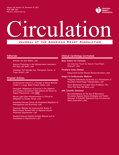Circulation:高花色素苷膳食降女性心梗风险
2013-01-23 Circulation CMT 高晓方 编译
英国学者的一项研究表明,富含花色素苷(一种类黄酮物质)膳食与女性偶发性心肌梗死风险降低32%具有相关性。论文于2013年1月14日在线发表于《循环》(Circulation)。 此项研究共纳入93,600例来自于护士健康研究II(NHS II)的女性受试者。受试者基线年龄介于25至42岁之间,并且接受每4年一次的食物频率问卷调查。伴有心血管疾病、冠脉血运重建和癌症病史的

英国学者的一项研究表明,富含花色素苷(一种类黄酮物质)膳食与女性偶发性心肌梗死风险降低32%具有相关性。论文于2013年1月14日在线发表于《循环》(Circulation)。
此项研究共纳入93,600例来自于护士健康研究II(NHS II)的女性受试者。受试者基线年龄介于25至42岁之间,并且接受每4年一次的食物频率问卷调查。伴有心血管疾病、冠脉血运重建和癌症病史的患者被排除在外。随访18年期间共发生405例心肌梗死。蓝莓、草莓、茄汁和黑莓等食物富含花色素苷。
结果显示,花色素苷摄入与心肌梗死风险负相关。与花色素苷摄入最低五分位者相比,摄入最高五分位者的校正心肌梗死危险比为0.68(P=0.03);花色素苷摄入每增加15 mg,校正心肌梗死风险相应降低17%。与每月进食蓝莓和草莓≤1次的受试者相比,每周进食≥3次的心肌梗死危险比为0.66(P=0.09)。上述草莓类浆果约占花色素苷摄入的60%。

Background—Our current knowledge of modifiable risk factors to prevent myocardial infarction (MI) in young and middle-aged women is limited, and the impact of diet is largely unknown. Dietary flavonoids exert potential beneficial effects on endothelial function in short-term trials; however, the relationship between habitual intake and risk of MI in women is unknown.
Methods and Results—We followed up 93 600 women 25 to 42 years of age from the Nurses’ Health Study (NHS) II who were healthy at baseline (1989) to examine the relationship between anthocyanins and other flavonoids and the risk of MI. Intake of flavonoid subclasses was calculated from validated food-frequency questionnaires collected every 4 years using an updated and extended US Department of Agriculture database. During 18 years of follow-up, 405 cases of MI were reported. An inverse association between higher intake of anthocyanins and risk of MI was observed (hazard ratio, 0.68; 95% confidence interval, 0.49–0.96; P=0.03, highest versus lowest quintiles) after multivariate adjustment. The addition of intermediate conditions, including history of hypertension, did not significantly attenuate the relationship (hazard ratio, 0.70; 95% confidence interval, 0.50–0.97; P=0.03). Combined intake of 2 anthocyanin-rich foods, blueberries and strawberries, tended to be associated with a decreased risk of MI (hazard ratio, 0.66; 95% confidence interval, 0.40–1.08) in a comparison of those consuming >3 servings a week and those with lower intake. Intakes of other flavonoid subclasses were not significantly associated with MI risk.
Conclusions—A high intake of anthocyanins may reduce MI risk in predominantly young women. Intervention trials are needed to further examine the health impact of increasing intakes of commonly consumed anthocyanin-rich foods.
本网站所有内容来源注明为“梅斯医学”或“MedSci原创”的文字、图片和音视频资料,版权均属于梅斯医学所有。非经授权,任何媒体、网站或个人不得转载,授权转载时须注明来源为“梅斯医学”。其它来源的文章系转载文章,或“梅斯号”自媒体发布的文章,仅系出于传递更多信息之目的,本站仅负责审核内容合规,其内容不代表本站立场,本站不负责内容的准确性和版权。如果存在侵权、或不希望被转载的媒体或个人可与我们联系,我们将立即进行删除处理。
在此留言







#心梗风险#
71
#色素#
58
#膳食#
63